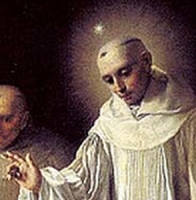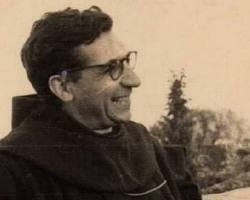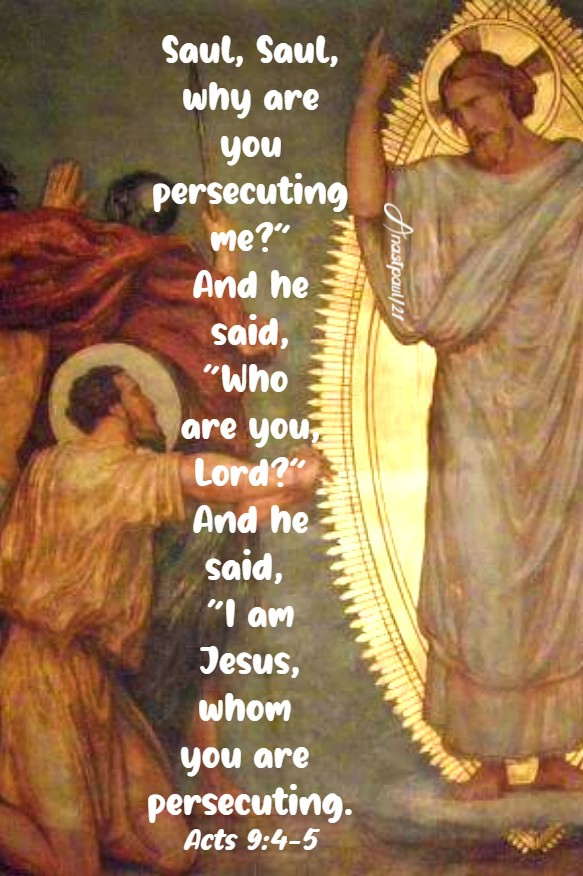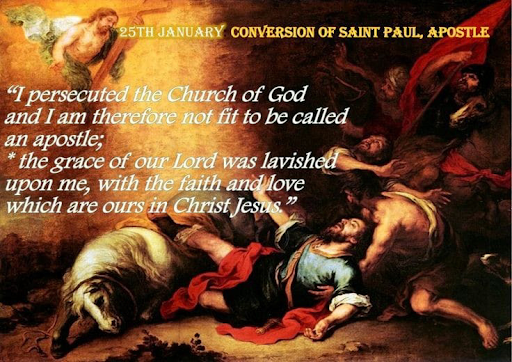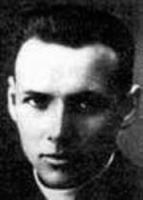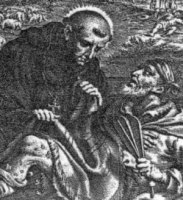Saint Robert of Molesme
Also known as
Robert of Cîteaux
Additional Memorial
26 January (Founders of the Cistercians)
Profile
Born to the French nobility. Benedictine monk in 1044. Prior of Moutiers-la-Celle Abbey. Abbot of Saint-Michel-de-Tonnerre, but considered it to have lax standards. Prior of Saint-Ayeul Abbey. In 1075, in an attempt to return to a simpler form of Benedictine life requested by a group of hermits from the forests around Colan, France, he helped found the monastery at Molesme, Burgundy. The group, especially Robert, gained a reputation for piety, which led to bequests of cash, which led to an increase in size of the monastery, which led to internal difficulties, and suddenly there were many brothers that objected to the severe life practised by the founders. Robert twice left to live on his own, but was ordered back to his position by the pope. In early 1098 Robert, Saint Stephen Harding, Saint Alberic of Citeaux and 18 other monks left Molesme, and on 21 March they founded the monastery of Cîteaux near Dijon, France, with the goal of living strictly by the Benedictine Rule, strict vows of poverty, and frequent retreats; Robert served as the first abbot. However, with conditions deteriorating at the Molesme house he was re-assigned as abbot there in 1100 with a mandate to reform; he lived and worked there the rest of his life. Traditionally considered one of the founders of the Cistercians, the reform that developed at Citeaux.
Born
1027 near Troyes, Champagne (in modern France)
Died
21 March 1110 of natural causes
Canonized
1222 by Pope Honorius III
Saint Timothy
புனிதர் திமொத்தேயு
ஆயர், மறைசாட்சி:
பிறப்பு: கி.பி. சுமார் 17
லிஸ்ட்ரா (Lystra)
இறப்பு: கி.பி. சுமார் 97 (வயது 79/80)
மசெடொனியா (Macedonia)
ஏற்கும் சபை/ சமயம்:
ரோமன் கத்தோலிக்க திருச்சபை
கீழை மரபுவழி திருச்சபை
ஓரியண்ட்டல் மரபுவழி திருச்சபை
ஆங்கிலிக்கன் சமூகம்
லூத்தரன் திருச்சபை
நினைவுத் திருவிழா: ஜனவரி 26
புனிதர் திமொத்தேயு, கிறிஸ்தவ சமயத்தின் முதல் நூற்றாண்டில் வாழ்ந்து, கி.பி. 97 அளவில் இறந்த ஒரு புனிதரும், பண்டைய கிரேக்க நகரமான “யூஃபேசஸ்” (Ephesus) எனுமிடத்தின் முதல் ஆயரும் ஆவார். "திமொத்தேயு" என்னும் பெயருக்கு "கடவுளைப் போற்றுபவர்" என்றும், "கடவுளால் போற்றப்பெறுபவர்" என்றும் பொருள் உண்டு.
விவிலியத்தின் புதிய ஏற்பாட்டின்படி திமொத்தேயு புனித பவுலோடு பயணம் செய்து கிறிஸ்தவ மறையைப் போதித்தார்; புனித பவுலின் சீடராக விளங்கினர். புனித பவுல் எழுதிய கடிதங்களுள் இரண்டு திமொத்தேயுவுக்கு எழுதப்பட்டவை ஆகும்.
(காண்க: 1 திமொத்தேயு, 2 திமொத்தேயு).
வாழ்க்கை வரலாறு:
திமொத்தேயு, “ஆசியா மைனர்” (Asia Minor) என்று அறியப்படும் “அனடோலியன் தீபகற்பத்தின்” (Anatolian peninsula) மத்திய பிராந்தியமான “லிஸ்ட்ராவின்” (Lystra) “லிக்கவோனியன்” (Lycaonian) நகரில் பிறந்தவர் ஆவார். இவரது தாயார் “யூனிஸ்” (Eunice), கிறிஸ்தவ விசுவாசத்திற்கு மனம் மாறிய ஒரு முன்னாள் யூதப் பெண்மணியாவார். இவரது தந்தையார் கிரேக்கத்தைச் சேர்ந்தவர் ஆவார்.
புனிதர் பவுலும், “அந்தியோக்கியா மற்றும் சைபிரஸ்” (Apostle to Antioch and Cyprus) ஆகிய நாடுகளின் அப்போஸ்தலருமான புனிதர் “பர்னபாஸ்” (Saint Barnabas) ஆகிய இருவரும் முதன்முதலாக “லிஸ்ட்ரா” (Lystra) நகர் வந்தபோது, பிறப்பிலிருந்து ஒரு ஊனமுற்ற ஒருவரை பவுல் குணப்படுத்தினார். பலர் அவரது போதனைகளை ஏற்றுக்கொள்வதற்கு வழிநடத்தினார்.
இவர் பற்றின சில குறிப்புகள் திருத்தூதர் பணிகள் நூலில் உள்ளன. புனித பவுல் தமது இரண்டாம் மறையறிவிப்புப் பயணத்தை மேற்கொண்ட போது அனத்தோலியா (Anatolia) பகுதியில் "லிஸ்ட்ராவுக்குச்" (Lystra) சென்றார்.
ஓரிடத்தில் பவுல், திமொத்தேயுவை "என் அன்பார்ந்த பிள்ளை" என்று அழைத்து, "ஆண்டவருடன் இணைந்து வாழும் அவர் நம்பிக்கைக்குரியவர்" என்று கூறுகின்றார்.
(1 கொரிந்தியர் 4:17).
மேலும் பவுல், திமொத்தேயுவைக் குறித்து "விசுவாச அடிப்படையில் என் உண்மையான பிள்ளை" என்கிறார்
(1 திமொத்தேயு 1:1).
இன்னோர் இடத்திலும் பவுல், திமொத்தேயுவை "என் அன்பார்ந்த பிள்ளை" என்று அழைக்கிறார்.
(2 திமொத்தேயு 1:1).
திமொத்தேயு பவுலோடு சேர்ந்து பல மறையறிவிப்புப் பயணங்களை மேற்கொண்டார். யூத மக்கள் அவரை ஏற்றுக்கொள்ள வேண்டும் என்றால் அவர் விருத்தசேதனம் செய்துகொள்ள வேண்டும் என்று உணர்ந்த பவுல் திமொத்தேயு யூத முறைப்படி விருத்தசேதனம் செய்ய ஏற்பாடு செய்தார்.
(காண்க: திருத்தூதர் பணிகள் 16:3).
திமொத்தேயு திருப்பணியில் அமர்த்தப்பட்டார். "இறைவாக்கு உரைத்து, மூப்பர்கள் உன்மீது கைகளை வைத்துத் திருப்பணியில் அமர்த்தியபோது உனக்கு அளிக்கப்பட்ட அருள்கொடையைக் குறித்து அக்கறையற்றவனாய் இராதே" என்று பவுல் திமொத்தேயுவுக்கு எழுதுகிறார்.
(காண்க: 1 திமொத்தேயு 4:14).
திமொத்தேயுவின் தாய் “யூனிஸ்” (Eunice) மற்றும் பாட்டி “லோயிஸ்” (Lois) இருவரும் கடவுள் நம்பிக்கையில் உறுதியாய் இருந்ததை பவுல் எடுத்துக்காட்டுகிறார்.
(காண்க: 2 திமொத்தேயு 1:5). அவர்கள் கிறிஸ்தவர்களாக இருந்திருக்கலாம்.
மற்றோர் இடத்தில் பவுல், திமொத்தேயு சிறந்த விவிலிய அறிவு கொண்டிருந்தார் என்பதைக் குறிப்பிடுகிறார்: "நீ குழந்தைப் பருவம் முதல் திருமறைநூலைக் கற்று அறிந்திருக்கிறாய். அது இயேசு கிறித்துவின் மீதுள்ள நம்பிக்கையால் உன்னை மீட்புக்கு வழி நடத்தும் ஞானத்தை அளிக்க வல்லது."
(காண்க: 2 திமொத்தேயு 3:15).
திமொத்தேயு ஒருமுறையாவது சிறையில் அடைக்கப்பட்டிருந்தார் என்பது எபிரேயர் திருமுகத்திலிருந்து தெரிகிறது: "நம் சகோதரர் திமொத்தேயு விடுதலை பெற்று விட்டார்."
(காண்க: எபிரேயர் 13:23).
திமொத்தேயுக்கு ஒருவித வயிற்று நோய் இருந்தது என்பதும் பவுலின் கூற்றிலிருந்து தெரிகிறது: "தண்ணீர் மட்டும் குடிப்பதை நிறுத்திவிட்டு, உன் வயிற்றின் நலனுக்காகவும், உனக்கு அடிக்கடி ஏற்படும் உடல்நலக் குறைவின்பொருட்டும் சிறிதளவு திராட்சை மதுவும் பயன்படுத்து."
(காண்க: 1 திமொத்தேயு 5:23).
எபேசு நகரில் தவறான கொள்கைகள் பரவும் ஆபத்து இருந்ததால் பவுல் திமொத்தேயுவிடம் அங்கேயே தங்கி இருக்கும்படி கூறுகிறார்: "நான் மாசிதோனியாவுக்குப் போகும்போது உன்னை எபேசில் இருக்கும்படி கேட்டுக்கொண்டேன். அங்கே சிலர் மாற்றுக் கொள்கைகளைக் கற்பிக்கின்றனர். அப்படிச் செய்யாதபடி அவர்களுக்குக் கட்டளையிடு."
(காண்க: 1 திமொத்தேயு 1:3).
எபேசு சபையில் தகுதிவாய்ந்த சபைக் கண்காணிப்பாளர்களையும் திருத்தொண்டர்களையும் தேர்ந்தெடுத்து நியமிப்பது குறித்து பவுல் திமொத்தேயுக்கு விரிவான வழிகாட்டல் தருகிறார்.
(காண்க: 1 திமொத்தேயு 3:1-13).
இந்த வழிமுறைகள் இன்றுவரை கடைப்பிடிக்கப்படுகின்றன.
பிற்கால மரபுச் செய்திகள்:
பிற்கால மரபுப்படி, பவுல் திமொத்தேயுவை கி.பி. 65ம் ஆண்டளவில் எபேசு சபையின் ஆயராகத் திருநிலைப்படுத்தினார். அங்கே திமொத்தேயு 15 ஆண்டுகள் பணிபுரிந்தார். கி.பி. 97ல், திமொத்தேயுவுக்கு 80 வயது ஆனபோது, அவர் பேகனிய சமயக் கொண்டாட்டங்களைத் தடுக்க முயன்றபோது அவர்கள் அவரைத் தெருவில் இழுத்துக் கொண்டுபோய் கல்லால் எறிந்து கொன்று போட்டனர்.
கி.பி. 4ம் நூற்றாண்டில் திமொத்தேயுவின் மீபொருள்கள் காண்ஸ்டாண்டிநோபுளில் தூய திருத்தூதர்கள் பேராலயத்திற்கு கொண்டு செல்லப்பட்டன.
வணக்கம்:
ரோமன் கத்தோலிக்க திருச்பையில் திமோத்தேயுக்கு பவுலின் மற்றொரு சீடரான தீத்து என்பவரோடு இணைத்து விழாக் கொண்டாடப்படுகிறது. அத்திருவிழா ஜனவரி 26ம் நாள் ஆகும்.
கீழை மரபுச் சபையில் திமொத்தேயு ஒரு திருத்தூதராகவும், புனிதராகவும், மறைசாட்சியாகவும் கருதப்படுகிறார். அவருடைய திருவிழா ஜனவரி 22ம் நாள் கொண்டாடப்படுகிறது.
Also known as
Timotheus
Additional Memorial
9 May (translation of relics)
Profile
His father was a Greek gentile, his mother Eunice was Jewish. Converted to Christianity by Saint Paul the Apostle around the year 47, he became a partner, assistant and close friend of Paul. Missionary. Head of the Church in Ephesus. Recipient of two canonical letters from Saint Paul. Martyred for opposing the worship of Dionysius.
Died
stoned to death in 97
Blessed José Gabriel del Rosario Brochero
Also known as
The Gaucho Priest
Profile
Fourth of ten brothers. Priest in the diocese of Córdoba, Argentina, ordained at age 26. Known to travel long distances in Argentina on the back of a mule, dressed in sombrero and poncho, to serve the needs of Christiansm throughout his huge parish. Cared for the sick during the cholera epidemic of 1867 He was contracted leprosy during his travels, and was blind toward the end.
Born
16 March 1840 in Santa Rosa de Río Primero, Córdoba, Argentina
Died
26 January 1914 in Villa del Tránsito, Córdoba, Argentina of leprosy
Beatified
his beatification miracle involved the healing of 13 year old Nicolas Flores who was in a vegetative state following a severe car crash
Canonized
on 21 January 2016, Pope Francis promulgated a decree of a miracle received through the intercession of Blessed José
Martyred Family of Constantinople
Profile
Saint Mary and Saint Xenophon were married and the parents of Saint John and Saint Arcadius. Theirs was a wealthy family of Senatorial rank in 5th century imperial Constantinople, but were known as a Christians who lived simple lives. To give their sons a good education, Xenophon and Mary sent them to university in Beirut, Phoenicia. However, their ship wrecked, there was no communication from them, and the couple assumed, naturally, that the young men had died at sea. In reality, John and Arcadius had survived and decided that instead of continuing to Beirut, they were going to follow a calling to religious life and became monks, eventually living in a monastery in Jerusalem. Years later, Mary and Xenophon made a pilgrimage to Jerusalem - where they encountered their sons. Grateful to have their family re-united, and taking it as a sign, Xenophon and Mary gave up their positions in society in Constantinople, and lived the rest of their lives as a monk and anchoress. in Jerusalem. A few years later, the entire family was martyred together.
Died
5th century Jerusalem
Saint Alberic of Citeaux
Also known as
Alberic of Aubrey
Profile
Hermit at Collan, Chatillon-sur-Seine, France. He, Saint Robert of Molesme, and several fellow hermits formed a monastery at Molesmes in 1075 with Alberic as prior. The group's reputation grew, and they attracted disciples, though some were not interested in living by the monastic rule. One of the house's co-founders, Robert, left, and when Alberic tried to enforce discipline, he was briefly imprisoned by his brothers; he finally gave up and left, as well.
In 1098, Alberic and Robert joined with Saint Stephen Harding and about twenty of their disappointed brothers from Molesmes to found a new house at Citeaux, France. This house became the foundation of the Cistercian Order, one of the greatest and most respected houses in the Church.
Alberic served first as prior, and then abbot, requiring strict adherence to the Benedictine Rule. Established the lay-brother element of the monastery. Introduced the Romanesque art form that is characteristic of early Cistercian houses.
Died
26 January 1109
Blessed Eystein Erlandsön
Also known as
• Augustine Erlandsön
• Augustinus Nidrosiensis
• Øystein Erlendsson
Profile
Born to the nobility, he studied in France. Priest. Court chaplain in the reign of King Inge Korkrygg. First archbishop of Nidaros (modern Trondheim), Norway in 1157; his suffragan dioceses included all of Iceland and Greenland. His reign was a constant fight to keep the Church separate from political influence, which required reform of the clergy in the region. Crowned the young king Magnus V. Political struggles forced him into three years of exile in England. Wrote a biography of Saint Olaf II. Expanded Christ Church cathedral, and established the administrative functions of the archdiocese.
Born
12th century Norway
Died
1188 in Nidaros, (modern Trondheim), Norway of natural causes
Saint Paula of Rome
சபை நிறுவுனர் உரோம் நகர் பவுலா Paula von Rom
பிறப்பு
347.
உரோம், இத்தாலி
இறப்பு
26 ஜனவரி,
பெத்லேஹெம்
இவர் ஓர் உயர்ந்த குடும்பத்தில் பிறந்தவர். இவர் ஓர் திருமணமான பெண். ஐந்து குழந்தைகளின் தாய். இவர் தனது கணவர் இறந்தபிறகு விதவையானார். தன் கணவர் இறந்த சில நாட்களிலேயே தான் ஓர் சிறந்த கிறிஸ்தவ பெண்ணாக வாழ வேண்டுமென்று விரும்பினார். சமூகப் பணிகள் பலவற்றில் ஈடுபட்டார். தேவையிலிருப்போரை இனங்கண்டு முன்வந்து உதவினார். இவர் சிறப்பாக எரோனிமுஸ் Hieronymus என்பவர் கற்றுக்கொடுத்த மாணவர்கள் பலருக்கு பல விதங்களில் உதவினார்.
இவர் 385 ஆம் ஆண்டு தனது மகளுடன் பாலஸ்தீன நாட்டிற்கு சென்றார். எரோனிமுஸ் காட்டிய வழியில் மறைவல்லுநர்கள் பலர் எழுதிய கடிதங்கலை தொகுத்து பாதுகாத்தார். பின்னர் 386ல் பாலஸ்தீனா நாட்டின் தாழ்வான பகுதியில் ஏராளமான திருயாத்திரை தலங்களையும், துறவற மடங்களையும் நிறுவினார். அத்துடன் சில பெண் துறவிகளுக்கு வழிகாட்டி அவர்களையும் தொடர்ந்து வழிநடத்தினார். சில ஆண்டுகள் கழித்து எரோனிமுஸும் அவரின் நண்பர்களும் இவரின் துறவற இல்லத்தில் வாழ்ந்து தங்களின் இறுதி நாட்களை கழித்தனர். அதன்பிறகு இவர் கிறிஸ்துவைப் பற்றி பரப்பவும் அவரை முழுமையாக அறியவும் பெத்லேகேம் சென்றார். அச்சமயத்தில்தான் இறந்தார்.
Also known as
• Paula the Widow
• Paulina, Pauline
Profile
Member of the Imperial Roman nobility, married to senator Toxotius. Mother of five children including Saint Eustochium and Saint Blaesilla. Widowed at age 32 in 379, she devoted her fortune and the rest of her life to spiritual development and care for the poor. Friend of Saint Marcella, Saint Epiphanius, and Saint Paulinus of Antioch. Friend, spiritual student and supporter of Saint Jerome whom she met in 382; he later wrote her biography. Pilgrim to the Holy Lands in 385. She settled in Bethlehem in 396 where she built churches, a hospice, monastery and convent where she served as the first abbess.
Born
5 May 347 at Rome, Italy
Died
• 404 at Bethlehem of natural causes
• buried under the Church of the Nativity at Nazareth
Saint Titus
புனிதர் தீத்துஸ்
ஆயர்/ மறைச்சாட்சி:
பிறப்பு: கி.பி. முதல் நூற்றாண்டு
இறப்பு: கி.பி. 96 அல்லது 107
கோர்ட்டின், கிரேட்
ஏற்கும் சபை/ சமயம்:
ரோமன் கத்தோலிக்க திருச்சபை
கிழக்கு மரபுவழி திருச்சபை
கிழக்கு மரபுவழி கத்தோலிக்க திருச்சபைகள்
லூத்தரன் திருச்சபை
ஆங்கிலிக்கன் சமூகம்
புனிதர் பட்டம்: வழிமுறைகளுக்கு முற்பட்ட காலம்
முக்கிய திருத்தலங்கள்:
ஹெராக்ளியோன் (Heraklion)
கிரேட் (Crete)
நினைவுத் திருவிழா: ஜனவரி 26
பாதுகாவல்: கிரேட் (Crete)
புனிதர் தீத்துஸ் (St. Titus), பண்டைய கிறிஸ்தவ சமய மறைப்பணியாளரும், திருச்சபையின் ஒரு தலைவரும், அப்போஸ்தலரான புனிதர் பவுலின் துணையாளரும், சீடரும் ஆவார். இவரைப்பற்றிய குறிப்புகள் பவுலின் பல திருமுகங்களில் காணக்கிடைக்கின்றன.
வாழ்க்கைக் குறிப்புகள்:
தீத்துஸ், பவுலோடும் பர்னபாவோடும் அந்தியோக்கியாவில் (Antioch) இருந்தார். பின்னர் அவர்களோடு எருசலேம் சங்கத்தில் கலந்துகொள்ளச் சென்றார். "பதினான்கு ஆண்டுகளுக்குப் பின் தீத்துசையும் கூட்டிகொண்டு பர்னபாவுடன் நான் மீண்டும் எருசலேமுக்குப் போனேன்" (கலாத்தியர் 2:1) என்று பவுல் எழுதுகிறார். ஆயினும் தீத்துஸின் பெயர் திருத்தூதர் பணிகள் நூலில் காணப்படவில்லை.
தீத்துஸ் யூத இனத்தைச் சாராத புற இனத்தவர் (Gentile) என்று தெரிகிறது. அவர் விருத்தசேதனம் செய்ய வேண்டிய தேவையில்லை என்று பவுல் மிகக் கண்டிப்பாகக் கூறியதிலிருந்து இது தெளிவாகிறது: "என்னுடன் இருந்த தீத்துஸ் கிரேக்கராய் இருந்தும் விருத்தசேதனம் செய்து கொள்ளுமாறு அவரை யாரும் கட்டாயப்படுத்தவில்லை" (கலாத்தியர் 2:3). கிறிஸ்தவ நம்பிக்கையை ஏற்று வாழ்வதற்கு விருத்தசேதனம் தேவையில்லை என்றுதான் பவுல் வாதாடினார்.
தீத்துஸ் ஆற்றிய அறப்பணி:
பவுல் எபேசு நகரில் கிறிஸ்தவத்தை அறிவித்தபோது, திமொத்தேயு மற்றும் தீத்துஸ் ஆகியோர் அவரோடு பணியாற்றினர். அங்கிருந்து பவுல் தீத்துசை கொரிந்து நகருக்கு அனுப்பினார். அந்நகரிலிருந்து காணிக்கை பிரித்து, எருசலேம் சபையினருக்கு உதவி செய்யும் நோக்கத்தோடு தீத்துஸ் அனுப்பப்பட்டார். "எனவே இந்த அறப்பணியைத் தொடங்கிய தீத்துசே அப்பணியை முடிக்க வேண்டும் என நாங்கள் அவரை வேண்டிக்கொண்டோம்" என்று பவுல் எழுதுகிறார் (2 கொரிந்தியர் 8:6).
வுல் மாசிதோனியாவில் பணிபுரிந்த போது, தீத்துஸ் அவரிடம் சென்றார். கொரிந்து நகரில் திருச்சபை வளர்ந்து வந்ததை தீத்துஸ் பவுலிடம் எடுத்துக் கூறினார். அது பற்றி பவுல் இவ்வாறு கூறுகிறார்: "மாசிதோனியாவிற்கு வந்து சேர்ந்த போது எங்களிடம் மன அமைதியே இல்லை. வெளியே போராட்டம், உள்ளே அச்சம்; இவ்வாறு எல்லா வகையிலும் துன்புற்றோம். தாழ்ந்தோருக்கு ஆறுதல் அளிக்கும் கடவுள் தீத்துஸின் வரவால் எங்களுக்கும் ஆறுதல் அளித்தார். அவரது வருகையால் மட்டும் அல்ல; நீங்கள் தீத்துஸுக்கு அளித்த ஆறுதலாலும் நாங்கள் ஆறுதல் அடைந்தோம். நாங்கள் மிகுதியான மகிழ்ச்சி அடைந்தோம்" (2 கொரிந்தியர் 7:5-8).
தீத்துஸ் “கிரேட்” (Crete) சபைக்குப் பொறுப்பேற்றல் :
இந்த நிகழ்ச்சிக்குப் பிறகு தீத்துஸின் பெயர், பவுல் சிறைப்பட்டதை ஒட்டியும், தீத்து கிரேட் (Crete) சபைக்குப் பொறுப்பேற்றது பற்றியும் வரும் குறிப்பில் மீண்டும் காணப்படுகிறது. "நான் உனக்குப் பணித்தபடியே கிரேட் தீவில் நீ மேலும் செய்ய வேண்டியவற்றை ஒழுங்குசெய்து, நகர்தோறும் மூப்பர்களை ஏற்படுத்த உன்னை அங்கே விட்டு வந்தேன்" (தீத்து 1:5) என்று பவுல் தீத்துஸுக்கு எழுதுகிறார்.
பவுல் உரோமையில் இருந்தபோது தீத்துஸ் தல்மாத்தியாவுக்குச் சென்றார் என்பதே தீத்துஸ் பற்றிய இறுதிக் குறிப்பு. "தேமா இன்றைய உலகப்போக்கை விரும்பி என்னை விட்டு அகன்று, தெசலோனிக்கா சென்றுவிட்டார். கிரேஸ்கு கலாத்தியாவுக்கும் தீத்துஸ் தல்மாத்தியாவுக்கும் சென்று விட்டனர்" (2 திமொத்தேயு 4:10) என்று பவுல் குறிப்பிடுகின்றார்.
இறப்பு:
தீத்துஸின் இறப்புப் பற்றிய குறிப்பு புதிய ஏற்பாட்டில் காணப்படவில்லை.
மரபுப்படி, பவுல் தீத்துசை ஆயராகத் திருநிலைப்படுத்தி, கிரேட் தீவின் 'கோர்ட்டின்' நகர ஆயராக அவரை நியமித்தார். தீத்துஸ் கி.பி. 107ல் தமது தொண்ணூற்று ஐந்தாம் வயதில் இறந்தார்.
புனித தீத்துஸின் மீபொருட்கள்:
துருக்கியர் ஆட்சிக்காலத்தில் வெனிசு நகருக்குக் கொண்டுபோகப்பட்டிருந்த புனித தீத்துஸின் மீபொருள்கள் அவர் பணிசெய்து உயிர்துறந்த கிரேட் தீவுக்கு 1969ம் ஆண்டு திருப்பி அனுப்பப்பட்டன. தற்போது அப்பொருட்கள் “கிரேட்” தீவில் அமைந்துள்ள ஹெராக்ளியோன்” ஆலயத்தில் வணக்கத்துக்கு வைக்கப்பட்டுள்ளன.
புனித தீத்துஸ் விருது:
ஐக்கிய அமெரிக்க நாடுகளின் படைத் திருப்பணியாளர்களில், சிறப்பான சேவை செய்வோருக்கு "புனித தீத்துஸ் விருது" என்ற பெயரில் விருது வழங்கப்படுகிறது.
Also known as
Titus of Crete
Additional Memorials
• 4 January (Corinth)
• 27 January (Norway; Trappists; Cistercians)
• 23 January (Australia)
• 25 August (Orthodox; Syrian)
• 1 August (Armenian)
• 24 August (Coptic)
Profile
Disciple of Saint Paul the Apostle. Recipient of a canonical letter from Saint Paul. First bishop of the Church in Crete.
Died
c.96 at Goryna, Crete
Blessed Michaël Kozal
Profile
Born to a peasant family. Ordained in 1918. Appointed auxiliary bishop of Wloclawek, Poland and titular bishop of Lappa by Pope Pius XII on 10 June 1939. Arrested by the Gestapo on 7 November 1939 as part of the Nazi persecution of the Catholic Church. Imprisoned and tortured at Wloclawek, Lad, Szczeglin, Berlin and Dachau. Spent 21 months in Dachau, ministering to other prisoners and being abused by the guards. Martyr.
Born
27 September 1893 at Ligota, Wielkopolskie, Poland
Died
martyred on 26 January 1943 in the Dachau concentration camp, Oberbayern, Germany
Beatified
14 June 1987 by Pope John Paul II in Poland
Blessed Marie de la Dive veuve du Verdier de la Sorinière
Additional Memorial
2 January as one of the Martyrs of Anjou
Profile
Married lay woman of the diocese of Angers, France. Martyred in the persecutions of the French Revolution.
Born
18 May 1723 in Saint-Crespin-sur-Moine, Maine-et-Loire, France
Died
18 January 1794 in Avrillé, Maine-et-Loire, France
Beatified
19 February 1984 by Pope John Paul II at Rome, Italy
Saint Ausilius of Fréjus
Also known as
Antiolo, Ausile, Ausilio, Auxile
Profile
Fifth bishop of Fréjus, France. Ausilius was noted for his austerity, seeming more like a hermit than the bishops of the day. Martyred in the persecutions of the Arian king Henry of the Visigoths.
Died
• 26 January 480
• buried on a hill in Callas-sur-Var, France where a church was built over his grave
• relics later enshrined at Callas-sur-Var
Blessed Arnaldo de Prades
Profile
Arnaldo worked as a barber, but felt a call to religious life. Mercedarian friar, joining during the early years of the Order. Noted preacher and evangelist. Ransomed many Christians from slavery in Muslim-held lands. Present at the death of Saint Peter Nolasco.
Saint Theogenes of Hippo
Also known as
• Theogenes of Bona
• Teógene of...
Profile
Third century bishop of Hippo in North Africa. Attended the Council of Carthage called by Saint Cyprian c.250. Martyred with 36 of his flock in the persecutions of Emperor Valerian. Saint Augustine of Hippo wrote about him.
Died
c.258
Saint Conan of Iona
Also known as
Mochonna of Iona
Profile
Monk at Iona. Tutor to the sons of King Eugene IV of Scotland. Spiritual teacher of Saint Fiacre. Missionary to the Isle of Man. Bishop of the Southern Hebrides and the Isle of Man.
Born
Ireland
Died
c.648 on the Isle of Man of natural causes
Saint Ansurius of Orense
Also known as
Aduri, Adurius, Isauri
Profile
Benedictine monk. Bishop of Orense, Galacia, Spain in 915. Founded the abbey of Ribas de Sil. In 922 he retired from his see, and spent his remaining years in prayer as a monk at Ribas de Sil.
Died
925 of natural causes
Blessed Claudio of San Romano
Profile
Mercedarian friar. Sent to Morocco in 1320, he ransomed many Christians held in slavery by Muslims.
Saint Tortgith of Barking
Also known as
Theoregitha, Thordgith, Thorgyth
Profile
Benedictine nun at the abbey of Barking, England. Novice-mistress during the time when Saint Ethelburga was her abbess.
Died
c.700
Saint Theofrid of Corbie
Also known as
Theofroy of Corbie
Profile
Benedictine monk at Luxeuil Abbey. Abbot of Corbie Abbey. Bishop.
Died
c.690 of natural causes
Saint Alphonsus of Astorga
Profile
Ninth century bishop of Astorga, Spain. He eventually retired to live as monk at the monastery of Saint Stephen de Ribas de Sil, Galicia, Spain.
Saint Athanasius of Sorrento
Profile
Bishop of Sorrento: He is documented as a bishop of Sorrento, Italy, but the exact time period of his episcopate is uncertain. Some sources place him in the 5th or 6th century, while others suggest he could have lived earlier, even in the 4th century.
Veneration: He is venerated as a saint in the Catholic Church
Saint Athanasius of Sorrento's feast day is celebrated on September 15th in the Catholic Church, some local sources in Sorrento do mention a secondary commemoration on January 26th.
Local tradition: Certain churches or communities within Sorrento might have adopted January 26th as a secondary feast day for Saint Athanasius, perhaps based on local legends or specific events associated with him.
Confusion with other saints: January 26th coincides with the feast day of another Saint Athanasius, namely Athanasius the Great, a prominent figure in early Christianity. Some confusion between the two saints, especially in older references, might lead to mentions of January 26th in relation to Athanasius of Sorrento.
Gabriel Mary Allegra
Blessed Gabriel Maria Allegra's feast day is celebrated on January 26th, the same day he passed away in 1976. This date holds deep significance, marking the anniversary of his return to God and the enduring legacy of his life and work.
Blessed Gabriel Maria Allegra (1907-1976) was an Italian Franciscan friar and biblical scholar, best known for his monumental task of translating the entire Catholic Bible into Chinese for the first time. His dedication and linguistic expertise earned him the title of "Apostle of the Chinese Bible."
Early Life and Calling:
Born Giovanni Stefano Allegra in San Giovanni la Punta, Sicily, in 1907, Gabriel felt drawn to religious life from a young age. He entered the Franciscan minor seminary at 11 and later joined the novitiate, taking the name "Gabriele Maria." Driven by a passion for scripture and a desire to share it with others, he pursued theological studies and eventually received his ordination as a priest in 1930.
Missionary Work in China:
Fueled by his missionary zeal, Fr. Allegra volunteered for service in China in 1931. He arrived in Beijing just as the country was facing political and religious turmoil, but his unwavering commitment to his mission remained strong. He spent the next two decades teaching at the Studium Biblicum Franciscanum in Beijing and Hong Kong, engaging in pastoral work, and tirelessly working on his magnum opus: the Chinese Bible translation.
Translating the Holy Scriptures:
Fr. Allegra's translation project was a monumental undertaking. He meticulously studied the original Hebrew and Greek texts, collaborating with a team of Chinese scholars to ensure accuracy and cultural sensitivity. The translation process spanned over 30 years, with the complete Bible finally published in 1968. This landmark achievement made the scriptures accessible to millions of Chinese Catholics for the first time, playing a crucial role in the growth and development of the Church in China.
Legacy and Veneration:
Fr. Allegra's dedication to the Chinese Bible translation earned him widespread respect and admiration. He died in 1976 and was beatified by Pope Benedict XVI in 2012, recognizing his exemplary life and contributions to the Church. Today, Blessed Gabriel Maria Allegra is remembered as a pioneer in Chinese Catholic biblical scholarship, a tireless missionary, and a true "Apostle of the Chinese Bible."
He was fluent in Italian, Latin, Greek, English, and Chinese.
He also translated other religious texts and wrote several books and articles on biblical themes.
His legacy continues to inspire future generations of missionaries and biblical scholars.
